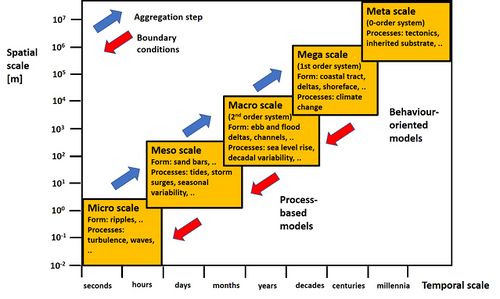Difference between revisions of "Coastal tract modelling"
Dronkers J (talk | contribs) |
Dronkers J (talk | contribs) |
||
| Line 4: | Line 4: | ||
Coastal evolution over centuries to millennia requires a broader outlook than for shorter time and space scales, in that the shoreline evolution must be linked to the behaviour of the continental shelf and coastal plain (Cowell et al., 2003a<ref>Cowell, P.J., Stive, M.J.F., Niederoda, A.W., de Vriend, H.J., Swift, D.J.P., Kaminsky, G.M. and Capobianco M. 2003a. The coastal-tract (part 1): a conceptual approach to aggregated modelling of low-order coastal change. Journal of Coastal Research, 19(4): 812 – 827.</ref>). The coastal tract is the combination of lower shoreface, upper shoreface and back barrier that comprises the first-order system within a coastal tract cascade, whereby greater and greater levels of detail are needed to model coastal evolution at shorter and shorter time-scales and space-scales (Figure 1). The coastal tract cascade formalises concepts for separating coastal processes and behaviour into a scale hierarchy. An additional concept, that of coastal tract templating was also introduced by Cowell et al. (2003b<ref>Cowell, P.J., Stive, M.J.F., Niederoda, A.W., Swift, D.J.P., de Vriend, H.J., Buijsman, M.C., Nicholls, R.J., Roy, P.S., Kaminsky, G.M., Cleveringa, J., Reed, C.W. and de Boer, P.L. 2003b. The coastal-tract (part 2): Applications of aggregated modelling of lower-order coastal change. Journal of Coastal Research 19(4): 828 – 848.</ref>) to provide a protocol for defining a site-specific problem by transforming data into a data model. | Coastal evolution over centuries to millennia requires a broader outlook than for shorter time and space scales, in that the shoreline evolution must be linked to the behaviour of the continental shelf and coastal plain (Cowell et al., 2003a<ref>Cowell, P.J., Stive, M.J.F., Niederoda, A.W., de Vriend, H.J., Swift, D.J.P., Kaminsky, G.M. and Capobianco M. 2003a. The coastal-tract (part 1): a conceptual approach to aggregated modelling of low-order coastal change. Journal of Coastal Research, 19(4): 812 – 827.</ref>). The coastal tract is the combination of lower shoreface, upper shoreface and back barrier that comprises the first-order system within a coastal tract cascade, whereby greater and greater levels of detail are needed to model coastal evolution at shorter and shorter time-scales and space-scales (Figure 1). The coastal tract cascade formalises concepts for separating coastal processes and behaviour into a scale hierarchy. An additional concept, that of coastal tract templating was also introduced by Cowell et al. (2003b<ref>Cowell, P.J., Stive, M.J.F., Niederoda, A.W., Swift, D.J.P., de Vriend, H.J., Buijsman, M.C., Nicholls, R.J., Roy, P.S., Kaminsky, G.M., Cleveringa, J., Reed, C.W. and de Boer, P.L. 2003b. The coastal-tract (part 2): Applications of aggregated modelling of lower-order coastal change. Journal of Coastal Research 19(4): 828 – 848.</ref>) to provide a protocol for defining a site-specific problem by transforming data into a data model. | ||
| − | The aggregate dynamics of the coastal tract are modelled using behaviour-orientated coastal change models and constrained by sediment mass conservation. The rate of coastal advance is governed by the balance between the change in sediment accommodation space caused by sea level rise and sediment availability. | + | The aggregate dynamics of the coastal tract are modelled using behaviour-orientated coastal change models and constrained by sediment mass conservation. The rate of coastal advance is governed by the balance between the change in sediment accommodation space caused by sea level rise and sediment availability. |
| + | |||
| + | |||
| + | ==Related articles== | ||
| + | : [[Case study: Applying ASMITA to UK estuaries]]. | ||
| + | : [[Behaviour-based models]] | ||
Latest revision as of 22:45, 10 November 2021
Coastal evolution over centuries to millennia requires a broader outlook than for shorter time and space scales, in that the shoreline evolution must be linked to the behaviour of the continental shelf and coastal plain (Cowell et al., 2003a[1]). The coastal tract is the combination of lower shoreface, upper shoreface and back barrier that comprises the first-order system within a coastal tract cascade, whereby greater and greater levels of detail are needed to model coastal evolution at shorter and shorter time-scales and space-scales (Figure 1). The coastal tract cascade formalises concepts for separating coastal processes and behaviour into a scale hierarchy. An additional concept, that of coastal tract templating was also introduced by Cowell et al. (2003b[2]) to provide a protocol for defining a site-specific problem by transforming data into a data model.
The aggregate dynamics of the coastal tract are modelled using behaviour-orientated coastal change models and constrained by sediment mass conservation. The rate of coastal advance is governed by the balance between the change in sediment accommodation space caused by sea level rise and sediment availability.
Related articles
References
- ↑ Cowell, P.J., Stive, M.J.F., Niederoda, A.W., de Vriend, H.J., Swift, D.J.P., Kaminsky, G.M. and Capobianco M. 2003a. The coastal-tract (part 1): a conceptual approach to aggregated modelling of low-order coastal change. Journal of Coastal Research, 19(4): 812 – 827.
- ↑ Cowell, P.J., Stive, M.J.F., Niederoda, A.W., Swift, D.J.P., de Vriend, H.J., Buijsman, M.C., Nicholls, R.J., Roy, P.S., Kaminsky, G.M., Cleveringa, J., Reed, C.W. and de Boer, P.L. 2003b. The coastal-tract (part 2): Applications of aggregated modelling of lower-order coastal change. Journal of Coastal Research 19(4): 828 – 848.
Please note that others may also have edited the contents of this article.
|
